|
The Internet is a powerful resource. It provides us instant
access to information, and brings us together via email,
bulletin boards, chat rooms, and instant messaging. FAOL
is a wonderful example of the Internet at its best. The Internet,
however, will never replace the printed page.
I've loved books and fishing since my youngest years, although
I did not start fly fishing until 1993. This column will give
me an opportunity to share reviews of some of my favorite fly
fishing and tying books (and some that are not such favorites)
with my friends here at FAOL. My library reflects my tastes
and interests, and so will this column. It will be heavily
slanted towards cold water fishing and tying for trout and
steelhead, and won't touch much on areas of which I know little,
such as warm or salt water fishing.
I hope that these reviews will motivate some of you to pick up
a good book, on this or any subject, and read.
~ Stu Farnham
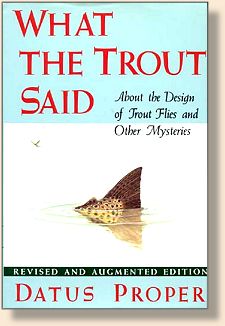 What the Trout Said, by Datus Proper (June 1996)
What the Trout Said, by Datus Proper (June 1996)
Hardcover - 304 pages Rev/augmnt edition
Dimensions (in inches): 1.04 x 8.49 x 5.79
The Lyons Press
ISBN: 1558210148
When I first saw it in print, I assumed that Datus Proper
was a pen name, like Sparse Grey Hackle. I was mistaken.
Proper is a former diplomat and a writer, whose latest work
is the collection of fishing essays Running Water.
Datus Proper is best known for his 1982 book on trout fly design,
What the Trout Said. The introduction to the 1982
edition was written, appropriately, by Vincent Marinaro, as this
book stands with Marinaro's Modern Dry Fly Code and
the work of Gary LaFontaine in providing informed insight into
why flies do and do not work.
The title of the book derives from the first section, a couple
of chapters under the heading of 'What the Trout Say About Fly
Design.' This section is summed up by a table comparing what
trout respond to in fly design to what anglers value. The surprise
is that the two have little in common! Part II is titled 'How
Insects Behave,' and covers behavior across the five main categories
of interest to the fly fisherman, as well as tactics and presentation.
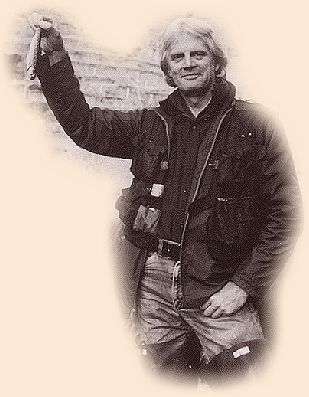
The first 80 pages have laid the groundwork. Next comes the
discussion of fly design. Part III deals first with the least
natural part of any fly, the hook. Here Proper anticipates
the detailed work done by Darrel Martin on hook geometries and
their fishing characteristics, based on empirical measurement.
He then talks about the important aspects of fly design, in
what I have come to believe to be priority order: size, shape
(profile), and color (note that I place presentation above all
of these, but that is primarily the responsibility of the angler,
not the fly designer).
The last part of the book presents fly designs, again distributed
across the major categories, and a set of notes on fly tying.
When reading this section, the contemporary fly fisher is first
struck by how few modern designs are found in a book only twenty
years old. I think this misses the crucial points of this book,
which speak not to what flies to tie, but rather how to think
about the flies you design, tie, and use.
This is a book that belongs in the library of any fly fisher or
tier who has progressed beyond the beginner stage. Well written,
entertaining, and insightful, it is a book I turn back to and
reread every few years.
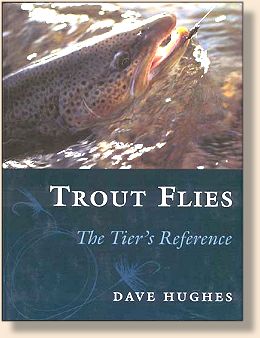 Trout Flies: The Tier's Reference by Dave Hughes
Trout Flies: The Tier's Reference by Dave Hughes
Hardcover - 480 pages 1 Ed edition (May 1999)
Dimensions (in inches): 1.33 x 11.24 x 8.73
ISBN: 0811716015
Stackpole Press
I need to confess to an affinity for Dave Hughes and his writing.
He's an Oregonian, and fishes a lot of the same water I do.
His Stackpole Press series Handbook of Hatches, Reading the Water,
Tactics for Trout, and Tackle and technique for Taking Trout
provided some of my early education in fly fishing. I
like his writing style, and, besides, he's a genuinely nice man.
Several more of his books will likely turn up in this series of
reviews.
Dave's 1999 book Trout Flies came out a bit after
The Fly Tier's Benchside Reference and the two are
often discussed together. Age and size notwithstanding, they are
very different books. The FTBR is a detailed
encyclopedia of almost every tying technique known. Trout
Flies, on the other hand describes a series of fly patterns
which can be tied in various sizes and colors to yield a set of
well-stocked fly boxes for fishing for trout. Along with each
pattern family, Dave discusses the situations in which each pattern
is useful, along with tips for presentation. Detailed tying
instructions are included for each pattern, accompanied by
Jim Schollmeyer's familiar and excellent photographs. Several
color variations are illustrated.
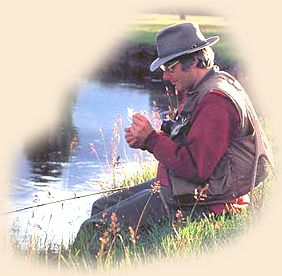
This book was criticized by some, who found its flies to be too
poorly tied for inclusion in a fly tying book. I don't agree
with this criticism. The flies look like they were tied by a
fisherman, to be fished, and the primary subject is how to fill
your fly boxes with useful flies, and how and when to fish them.
For those who don't want to pay the $75 list price (or the $50
discounted price that can be found on the Internet), Dave produced
a scaled-down version titled Essential Trout Flies.
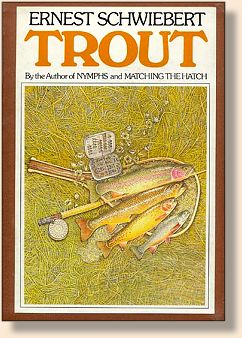 Trout by Ernest Schwiebert
Trout by Ernest Schwiebert
Hardcover 2nd edition Vol S02 (September 1984)
E P Dutton; ISBN: 0525242694
OK, time for a riddle: what weighs almost seven pounds and
has a page count that splits the difference between Gone
with the Wind and The Shorter Oxford English Dictionary?
Give up? It's Ernest Schwiebert's Trout, a book whose
size (two volumes, 1832 pages) and scope matches its author's
position among North American fishing writers. Among Schwiebert's
works are Nymphs (1973), the first systematic
examination of the immature forms of North American insects
of the trout fisherman, and Matching the Hatch (1955),
a seminal book in the transition from fishing 'lures' and attractors
to using closer approximations of the natural.
It's perhaps presumptuous of me to write a review of this book,
because I have not yet, after owning it for three years, read
it cover to cover. The two volumes cover every imaginable topic
of interest to those who fly fish for trout.
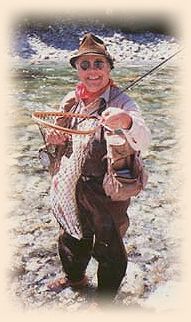
Book One, 'The Evolution of Flyfishing,' provides a historical
perspective, with the emphasis on fly fishing in England the
North America. Book Two covers the major American species of
trout, char, and grayling, and Book Three their physiology,
habitat, and behavior. Book Four concentrates on equipment:
lines, leaders, knots, reels, rods (the chapter in split cane
is a wonderful introduction to those rods), and clothing, and
adds a chapter on fly dressing. Book Five deals with the basic
skills of casting and wading, hooking, playing, landing, and
releasing fish, and reading water. The sixth and final book
discusses strategies, techniques, and tactics. It also deals
with the important (but neglected) subjects of ethics and
etiquette.
The illustrations are mostly by Schwiebert himself (check out
his renderings of immature insects in Nymphs). The book
includes an extensive bibliography as well as a detailed
index running almost 70 pages.
Schwiebert's style mixes factual discourse with personal anecdotes
and opinions. A book of this size could as easily kill with boredom
as with sheer mass, but this one is extremely readable. I use it
as a reference volume, when I want a quick survey of some area or
other. I also open it at random and read whatever chapter falls
open. The book is out of print and spendy when a copy in good
condition can be found. However, if you read about fly fishing
for trout as avidly as you fly fish, it's a wonderful investment
of your money and your time.
About Stu
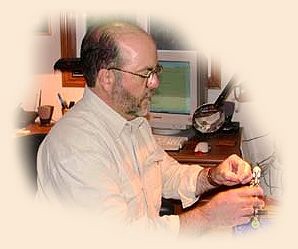 Stu Farnham is a New Englander by birth, who was transplanted to
and put down roots in Oregon in the early 1990s. A software
engineering manager by vocation, he can be found in his spare
time chasing trout and steelhead in the rivers of the Pacific
Northwest, chasing his four Gordon Setters (who in turn are
chasing chukar), tying flies, reading, or working on his website.
Colleen, his long suffering wife of 28 years, is a professionally
trained personal chef.
Stu Farnham is a New Englander by birth, who was transplanted to
and put down roots in Oregon in the early 1990s. A software
engineering manager by vocation, he can be found in his spare
time chasing trout and steelhead in the rivers of the Pacific
Northwest, chasing his four Gordon Setters (who in turn are
chasing chukar), tying flies, reading, or working on his website.
Colleen, his long suffering wife of 28 years, is a professionally
trained personal chef.
|
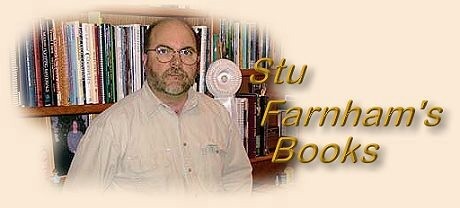
 What the Trout Said, by Datus Proper (June 1996)
What the Trout Said, by Datus Proper (June 1996) Stu Farnham is a New Englander by birth, who was transplanted to
and put down roots in Oregon in the early 1990s. A software
engineering manager by vocation, he can be found in his spare
time chasing trout and steelhead in the rivers of the Pacific
Northwest, chasing his four Gordon Setters (who in turn are
chasing chukar), tying flies, reading, or working on his website.
Colleen, his long suffering wife of 28 years, is a professionally
trained personal chef.
Stu Farnham is a New Englander by birth, who was transplanted to
and put down roots in Oregon in the early 1990s. A software
engineering manager by vocation, he can be found in his spare
time chasing trout and steelhead in the rivers of the Pacific
Northwest, chasing his four Gordon Setters (who in turn are
chasing chukar), tying flies, reading, or working on his website.
Colleen, his long suffering wife of 28 years, is a professionally
trained personal chef.

 Trout Flies: The Tier's Reference by Dave Hughes
Trout Flies: The Tier's Reference by Dave Hughes
 Trout by Ernest Schwiebert
Trout by Ernest Schwiebert